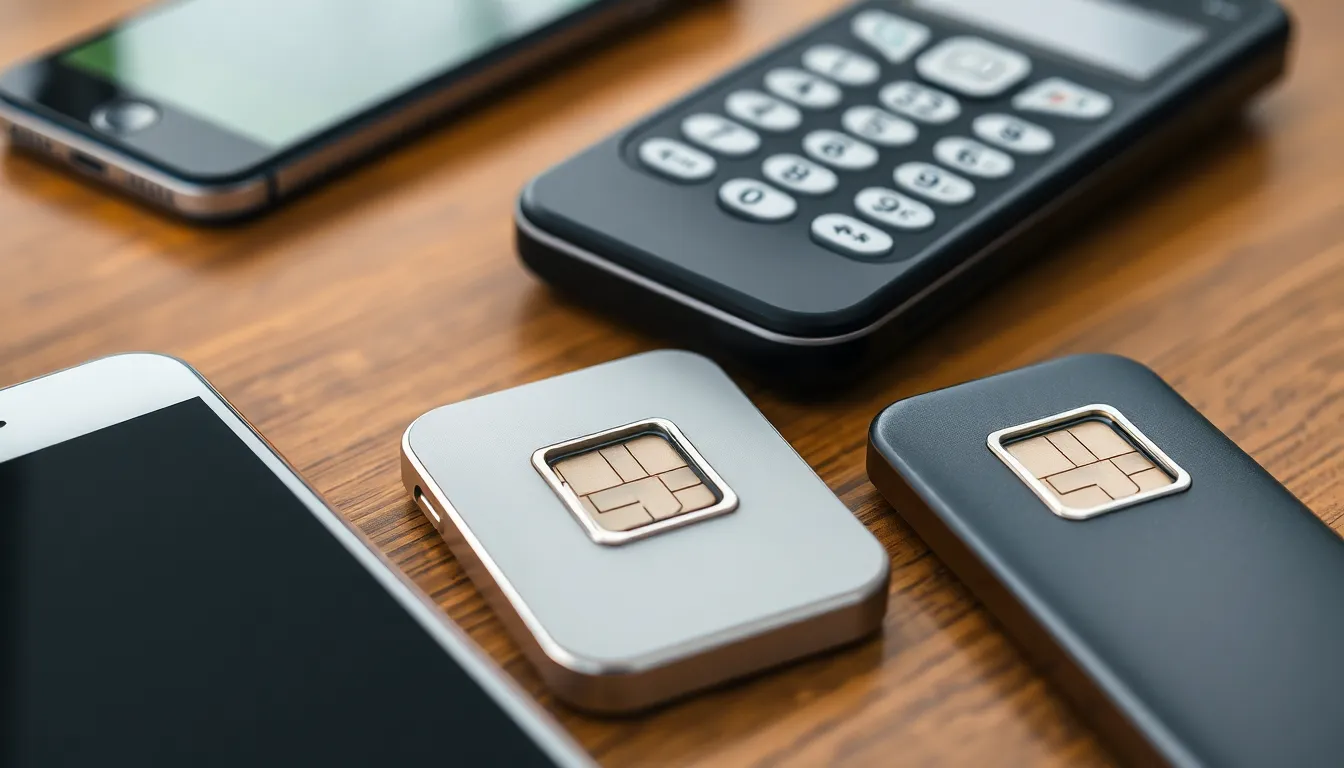In a world where smartphones reign supreme, one question often pops up: do all phones have SIM cards? It’s like asking if all fish can swim—some can, but not all. While the majority of modern phones rely on SIM cards to connect to cellular networks, there are exceptions lurking in the shadows, like that one sock that always goes missing in the laundry.
Table of Contents
ToggleOverview of SIM Cards
SIM cards play a critical role in mobile communication. While most smartphones use them to connect to cellular networks, some devices operate without them.
What Is a SIM Card?
A SIM card, or Subscriber Identity Module, is a small chip that authenticates a device on a cellular network. This card stores important information, such as the user’s phone number, contact details, and data encryption keys. Found in various forms, including nano, micro, and standard sizes, SIM cards fit into designated slots in phones, allowing connectivity to the network.
Purpose of a SIM Card
The primary purpose of a SIM card centers on enabling communication. It links the device to a service provider, facilitating calls and internet access. Users rely on SIM cards for sending texts, browsing the web, and utilizing mobile data. Additionally, SIM cards provide security by authenticating the user’s identity, ensuring secure access to network services.
Types of Phones

Different types of phones each have varying connections to SIM cards. Understanding these categories clarifies which devices require SIM cards and which don’t.
Smartphones and SIM Cards
Smartphones predominantly utilize SIM cards for cellular connectivity. A SIM card allows users to make calls, send texts, and access mobile data. Most modern smartphones feature a SIM card slot, accommodating either a physical SIM or an eSIM. Users typically choose smartphones from brands like Apple or Samsung, which integrate SIM technology for seamless communication. Therefore, smartphones without SIM cards are rare in today’s market.
Feature Phones and SIM Cards
Feature phones act as a bridge for basic communication, often including SIM card functionality. Many feature phones enable calls and SMS without advanced data capabilities. These devices typically support a physical SIM card, allowing users to connect to mobile networks. While not as common as smartphones, feature phones serve essential purposes for users who prioritize simplicity. In many cases, users can find feature phones equipped with SIM card slots from various manufacturers.
VoIP Phones and SIM Cards
VoIP phones primarily connect through internet protocols, making SIM cards unnecessary. Relying on Wi-Fi or Ethernet, these phones provide a different communication medium. Users with VoIP services, such as Skype or Zoom, often access calls without cellular networks. While some VoIP-compatible devices may include optional SIM capabilities, VoIP phones remain more focused on internet connectivity. Thus, the typical VoIP phone does not require a SIM card for functionality.
Phones Without SIM Cards
Some phones don’t use traditional SIM cards. These devices leverage alternative technologies for connectivity.
Understanding eSIM Technology
eSIM technology represents a digital version of the SIM card. It functions in the same way but eliminates the need for a physical card. Users can activate cellular plans directly from their devices without swapping out cards. Many modern smartphones, such as the latest models from Apple and Google, support eSIM. This offers flexibility in managing accounts and carriers. With eSIM, switching networks becomes easier, as users can store multiple profiles.
Devices That Rely on Wi-Fi
Devices relying solely on Wi-Fi provide alternatives to cellular networks. VoIP phones exemplify this category by utilizing internet connections for calls. They offer features for messaging and video calls through various applications. Tablets and smartwatches also often connect to the internet without needing a SIM card. Using Wi-Fi enhances communication options, while eliminating cellular dependency. These devices capitalize on available internet connections, making them suitable for home and office environments.
Regional Differences
Regional differences significantly affect SIM card availability and usage in mobile devices. These variations arise from local telecommunications infrastructure and consumer preferences.
Availability of SIM Cards Worldwide
Availability of SIM cards varies across countries. Some regions provide widespread access to physical SIM cards due to extensive network coverage. Countries like the United States and India feature abundant SIM card options from various carriers. In contrast, rural areas may face limitations in availability, impacting the options for consumers. Many developing nations prioritize mobile connectivity, leading to increased efforts to distribute SIM cards, offering affordable plans and promotions.
Regulations Impacting SIM Card Usage
Regulations influence SIM card usage and activation processes. In many regions, government policies require users to register SIM cards under their names for security reasons. This approach aims to reduce fraud and enhance accountability. Countries like China and India have strict registration processes that users must navigate. Restrictions also exist on the devices that can access cellular networks, impacting the compatibility of SIM cards. Understanding these regulations is crucial for consumers when selecting devices and services.
Not every phone requires a SIM card for functionality. While most smartphones and feature phones depend on SIM cards for cellular connectivity, alternatives like eSIM technology and Wi-Fi-based devices provide flexibility in communication. Regional differences and regulatory factors also play a significant role in how SIM cards are utilized across various markets. Understanding these nuances helps consumers make informed choices about their devices and connectivity options. Ultimately, the landscape of mobile communication continues to evolve, offering diverse solutions to meet users’ needs.



